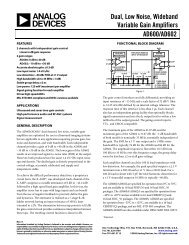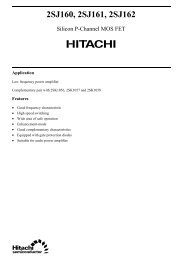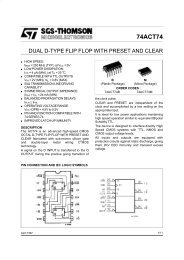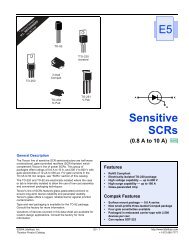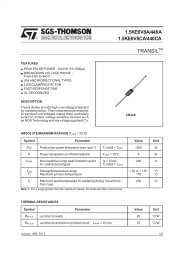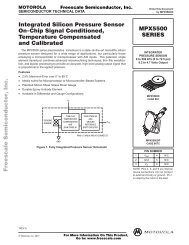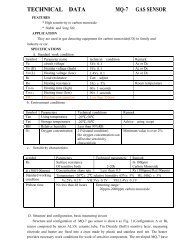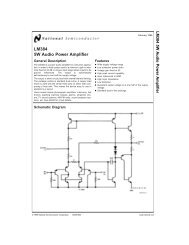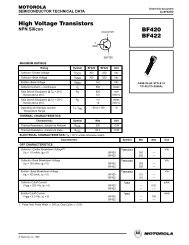TMS320F206 Digital Signal Processor (Rev. A) - Futurlec
TMS320F206 Digital Signal Processor (Rev. A) - Futurlec
TMS320F206 Digital Signal Processor (Rev. A) - Futurlec
Create successful ePaper yourself
Turn your PDF publications into a flip-book with our unique Google optimized e-Paper software.
<strong>TMS320F206</strong>DIGITAL SIGNAL PROCESSORSPRS050A – NOVEMBER 1996 – REVISED APRIL 1998central arithmetic logic unit (continued)The CALU overflow saturation mode can be enabled/disabled by setting/resetting the OVM bit of ST0. Settingthe OVM status register bit selects the overflow saturation mode. When the CALU is in the overflow saturationmode and an overflow occurs, the overflow flag is set and the accumulator is loaded with either the most positiveor the most negative value representable in the accumulator, depending upon the direction of the overflow. Thevalue of the accumulator upon saturation is 07FFFFFFFh (positive) or 080000000h (negative). If the OVM(overflow mode) status register bit is reset and an overflow occurs, the overflowed results are loaded into theaccumulator without modification. (Note that logical operations cannot result in overflow.)The CALU can execute a variety of branch instructions that depend on the status of the CALU and accumulator.These instructions can be executed conditionally, based on various combinations of the associated status bits.For overflow management, these conditions include the OV (branch on overflow) and EQ (branch onaccumulator equal to zero). In addition, the BACC (branch-to-address in accumulator) instruction provides theability to branch to an address specified by the accumulator (computed goto). Bit test instructions (BIT andBITT), which do not affect the accumulator, allow the testing of a specified bit of a word in data memory.The CALU also has a carry bit (bit 9 of status register ST1) that facilitates efficient computation ofextended-precision products and additions or subtractions. The carry bit is also useful in overflow management.The carry bit is affected by the following operations:Additions to and subtractions from the accumulator:C = 0: When the result of a subtraction generates a borrow.When the result of an addition does not generate a carry. (Exception: When the ADD instruction isused with a shift of 16 and no carry is generated, the ADD instruction has no effect on C.)C = 1: When the result of an addition generates a carry.When the result of a subtraction does not generate a borrow. (Exception: When the SUB instructionis used with a shift of 16 and no borrow is generated, the SUB instruction has no effect on C.)Single-bit shifts and rotations of the accumulator value. During a left shift or rotation, the most significantbit of the accumulator is passed to C; during a right shift or rotation, the least significant bit is passed to C.Note: the carry bit is set to “1” on a hardware reset.The ADDC (add to accumulator with carry) and SUBB (subtract from accumulator with borrow) instructionsprovided, use the previous value of carry in their addition/subtraction operation.accumulatorThe 32-bit accumulator is the registered output of the CALU. It can be split into two 16-bit segments for storagein data memory. Shifters at the output of the accumulator provide a left shift of 0 to 7 places. This shift isperformed while the data is being transferred to the data bus for storage. The contents of the accumulatorremain unchanged. When the post-scaling shifter is used on the high word of the accumulator (bits 16–31), theMSBs are lost and the LSBs are filled with bits shifted in from the low word (bits 0–15). When the post-scalingshifter is used on the low word, the LSBs are zero-filled.The SFL and SFR (in-place one-bit shift to the left/right) instructions and the ROL and ROR (rotate to theleft/right) instructions implement shifting or rotating of the accumulator contents through the carry bit. The SXMbit affects the definition of the SFR (shift accumulator right) instruction. When SXM=1, SFR performs anarithmetic right shift, maintaining the sign of the accumulator data. When SXM=0, SFR performs a logical shift,shifting out the LSBs and shifting in a zero for the MSB. The SFL (shift accumulator left) instruction is not affectedby the SXM bit and behaves the same in both cases, shifting out the MSB and shifting in a zero. Repeat (RPT)instructions can be used with the shift and rotate instructions for multiple-bit shifts.14 POST OFFICE BOX 1443 • HOUSTON, TEXAS 77251–1443



